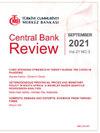Does difference in monetary policy framework matter for interest rate Pass-through? Evidence from TVP-VAR with stochastic volatility
IF 1.2
Q2 ECONOMICS
引用次数: 0
Abstract
The relative success of Inflation Targeting (IT) amidst widespread rising inflation globally is motivating the Central Bank of Nigeria (CBN) to renew its desire for an IT framework. This paper applies the Time-Varying Parameter Structural Vector Autoregression with the Stochastic Volatility model (TVP-SVAR-SVM) to examine the potential benefits and provide hindsight for the CBN within the interest rate channel. The paper draws parallels between the CBN's Monetary Targeting (MT) and South Africa's Reserve Bank (SARB) IT. The result of the SVM uncovers a disparity regarding inflation uncertainty associated with interest rate pass-through. At the same time, two distinct parallels were unveiled regarding the impulse response function (IRF) result. Although CBN was found to have experienced decelerating inflation uncertainty, the SARB's IT shows no potential benefit. Meanwhile, compelling distinctiveness from the results of the IRF is: first, relative consistency in short-term inflation forecast and the future expected inflation (8-period and 12-period) found in the SARB's IT. This was accompanied by an observed absence of distortions over the declining trajectory of inflation, which allows it to build monetary policy credibility over time, while the strong indication of achieving rapid long-run disinflation over time was also detected. Thus, confirming the relatively greater degree of expectation anchoring. In contrast, the CBN's MT showed manifestation of distortions over time, with difficulties in suppressing impending inflationary pressure, whereas the expected inflation forecast deviated from its short-term (4-period) inflation forecast. Secondly, evidence of speed in the SARB's IT during the initial impact of interest rate pass-through was twice as fast as the CBN's MT. Consequently, the total impact of the pass-through to inflation under MT was also found to be delayed by 8 periods relative to the IT. This paper concludes that the characterized evidence uncovered constitutes a relatively effective SARB's IT, and a key benefit resides in the comparatively faster interest rate pass-through in the IT. This could potentially restrain the rapidness with which nominal adjustable inflation-indexed wages under short contracts have on inflation.
货币政策框架的差异对利率传递有影响吗?随机波动的TVP-VAR证据
在全球通货膨胀普遍上升的背景下,通货膨胀目标制(IT)的相对成功促使尼日利亚中央银行(CBN)重申其对IT框架的渴望。本文应用时变参数结构向量自回归与随机波动模型(TVP-SVAR-SVM)来检查潜在的好处,并为利率通道内的CBN提供后见之明。本文将CBN的货币目标(MT)与南非储备银行(SARB) IT进行了比较。支持向量机的结果揭示了与利率传递相关的通货膨胀不确定性的差异。同时,在脉冲响应函数(IRF)的结果上,揭示了两个明显的相似之处。尽管发现CBN经历了通货膨胀减速的不确定性,但SARB的IT没有显示出潜在的好处。与此同时,IRF结果的引人注目的独特性是:首先,在SARB的IT中发现的短期通胀预测和未来预期通胀(8期和12期)的相对一致性。与此同时,人们还观察到通货膨胀下降轨迹没有出现扭曲,这使得它能够随着时间的推移建立货币政策的可信度,同时也发现了随着时间的推移实现长期快速反通货膨胀的强烈迹象。从而证实了相对较大程度的期望锚定。相比之下,CBN的MT表现出随时间的扭曲,难以抑制即将到来的通胀压力,而预期通胀预测偏离其短期(4期)通胀预测。其次,在利率传递的初始影响期间,SARB的IT速度是CBN MT的两倍。因此,在MT下传递对通货膨胀的总影响也被发现相对于IT延迟了8个时期。本文的结论是,所发现的特征证据构成了一个相对有效的储蓄银行的IT,关键的好处在于相对较快的利率传递在IT中。这可能会抑制短期合同下的名义可调整通胀指数工资对通胀的快速影响。
本文章由计算机程序翻译,如有差异,请以英文原文为准。
求助全文
约1分钟内获得全文
求助全文

 求助内容:
求助内容: 应助结果提醒方式:
应助结果提醒方式:


